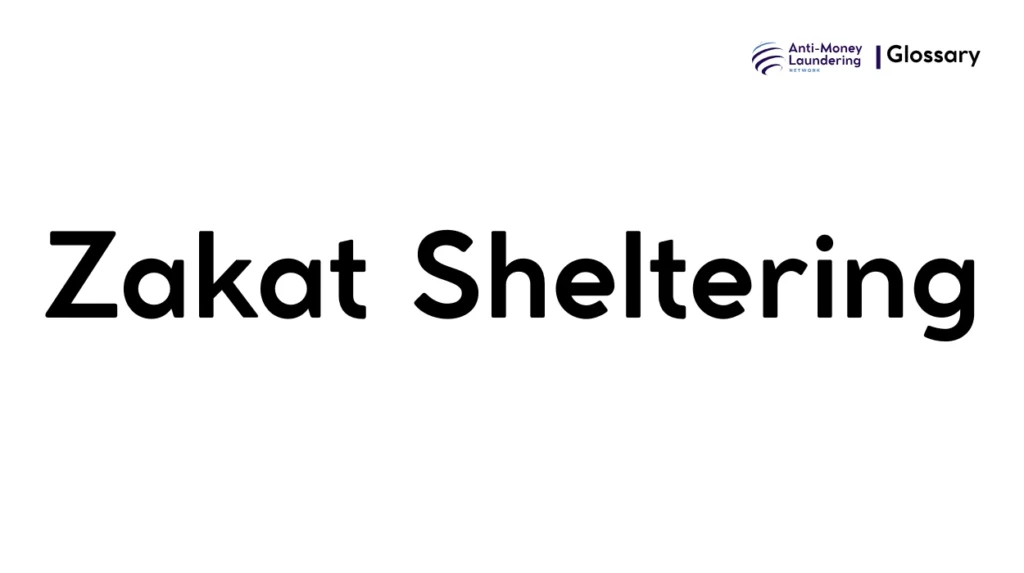Definition
ZakatSheltering in Anti-Money Laundering (AML) refers to the misuse or manipulation of Zakat, an Islamic charitable obligation, as a means to shelter illicit funds or launder money. It involves disguising the origins of unlawful proceeds by channeling them through Zakat payments, charities, or religious financial channels to provide an appearance of legitimacy and compliance with religious and social norms, thereby evading AML controls.
Purpose and Regulatory Basis
The role of understanding and preventing ZakatSheltering within AML frameworks is to close loopholes that criminals exploit by exploiting religious or charitable financial activities. Since Zakat involves mandatory financial transfers in Islamic finance, criminals may abuse this system to obscure the source of “dirty money,” legitimizing it by labeling it as charitable donations.
Globally, FATF (Financial Action Task Force) recommendations emphasize regulating charities and nonprofits due to their vulnerability to abuse for money laundering and terrorist financing. National regulations such as the USA PATRIOT Act and the EU’s Anti-Money Laundering Directives (AMLD) similarly mandate robust due diligence and monitoring of charitable institutions and religious giving channels, explicitly to prevent their exploitation for illicit finance.
When and How it Applies
ZakatSheltering applies specifically in contexts where financial institutions, charities, or Islamic financial entities handle Zakat funds. Potential triggers include unusually large or frequent Zakat payments inconsistent with typical donor profiles, lack of transparency in the flow and use of these funds, or involvement by politically exposed persons (PEPs) or high-risk jurisdictions.
For example, a money launderer may donate illicit funds as Zakat via an affiliated charity that lacks proper AML controls. The charity then disburses this “cleaned” money through legitimate charitable projects or employee salaries, integrating illicit funds into the financial system.
Types or Variants
- Direct ZakatSheltering: Illicit funds are directly paid as Zakat to religious or charitable institutions without undergoing adequate AML scrutiny.
- Indirect ZakatSheltering: Illicit funds route through complex networks involving multiple Zakat-paying entities or intermediaries before reaching the beneficiary, complicating traceability.
- Institutional ZakatSheltering: Charitable organizations themselves may serve explicitly or implicitly as shelters for laundering if governance and compliance are weak.
Procedures and Implementation
Financial institutions and charities must implement robust AML procedures focused on Zakat transactions:
- Risk Assessment: Institutions must assess the risks related to Zakat transactions based on donor profiles, jurisdictions, and transaction volumes.
- Customer Due Diligence (CDD): Verify identities and sources of funds for donors making Zakat payments.
- Transaction Monitoring: Monitor Zakat payments for unusual patterns, inconsistencies, or large volumes.
- Charity Oversight: Monitor and audit organizations issuing or receiving Zakat to confirm proper fund use.
- Training: AML staff should be trained to understand Zakat-specific risks and detection methods.
Impact on Customers/Clients
Clients may face enhanced scrutiny when making Zakat payments, including requests for documentation proving the source of funds and more thorough identification processes. While respecting religious obligations, institutions must balance customer rights with AML obligations, ensuring transparency without impeding legitimate Zakat giving.
Duration, Review, and Resolution
Institutions must continuously review flagged Zakat-related activities, with ongoing monitoring and periodic audits. Suspicious transactions or behaviors should be reported promptly to the relevant Financial Intelligence Unit (FIU) or regulatory body. Resolution may involve freezing suspicious funds or further investigation.
Reporting and Compliance Duties
Institutions handling Zakat funds bear responsibility for:
- Maintaining thorough records of Zakat transactions.
- Filing Suspicious Activity Reports (SARs) when Zakat is suspected as a sheltering method.
- Implementing AML policies tailored to charitable giving.
- Ensuring governance and oversight extend to charitable entities involved in Zakat distribution.
Penalties for non-compliance can include fines, reputational damage, and regulatory sanctions.
Related AML Terms
- Charity Hijacking: Abuse of charitable organizations for money laundering or terrorist financing.
- Terrorist Financing: Using religious donations to fund terrorism.
- Customer Due Diligence (CDD): Processes to verify customers and monitor transactions.
- Layering: Complex financial transactions to conceal illicit origins, relevant to indirect ZakatSheltering.
- Financial Intelligence Unit (FIU): National bodies analyzing suspicious financial activities including charity abuse.
Challenges and Best Practices
- Challenges: Differentiating legitimate religious giving from illicit sheltering; religious sensitivities; lack of transparency from informal charitable channels.
- Best Practices: Collaborate with religious authorities; apply technology-driven monitoring; tailor AML training and controls to cultural contexts; promote transparency and governance in charities.
Recent Developments
Recent AML frameworks increasingly recognize vulnerabilities in religious and charitable giving. Technology such as AI-powered transaction monitoring enhances detection of Zakat-related sheltering. Greater regulatory focus on nonprofit sectors with enhanced due diligence requirements is evolving globally.
ZakatSheltering in AML is a critical consideration for financial and charitable institutions in Islamic contexts. It involves the misuse of religious charitable giving to conceal illicit funds, presenting unique challenges in detection and compliance. Effective implementation of tailored AML controls, risk assessment, and cooperation with regulatory and religious bodies are essential to mitigate this risk and uphold the integrity of financial systems and religious obligations.

